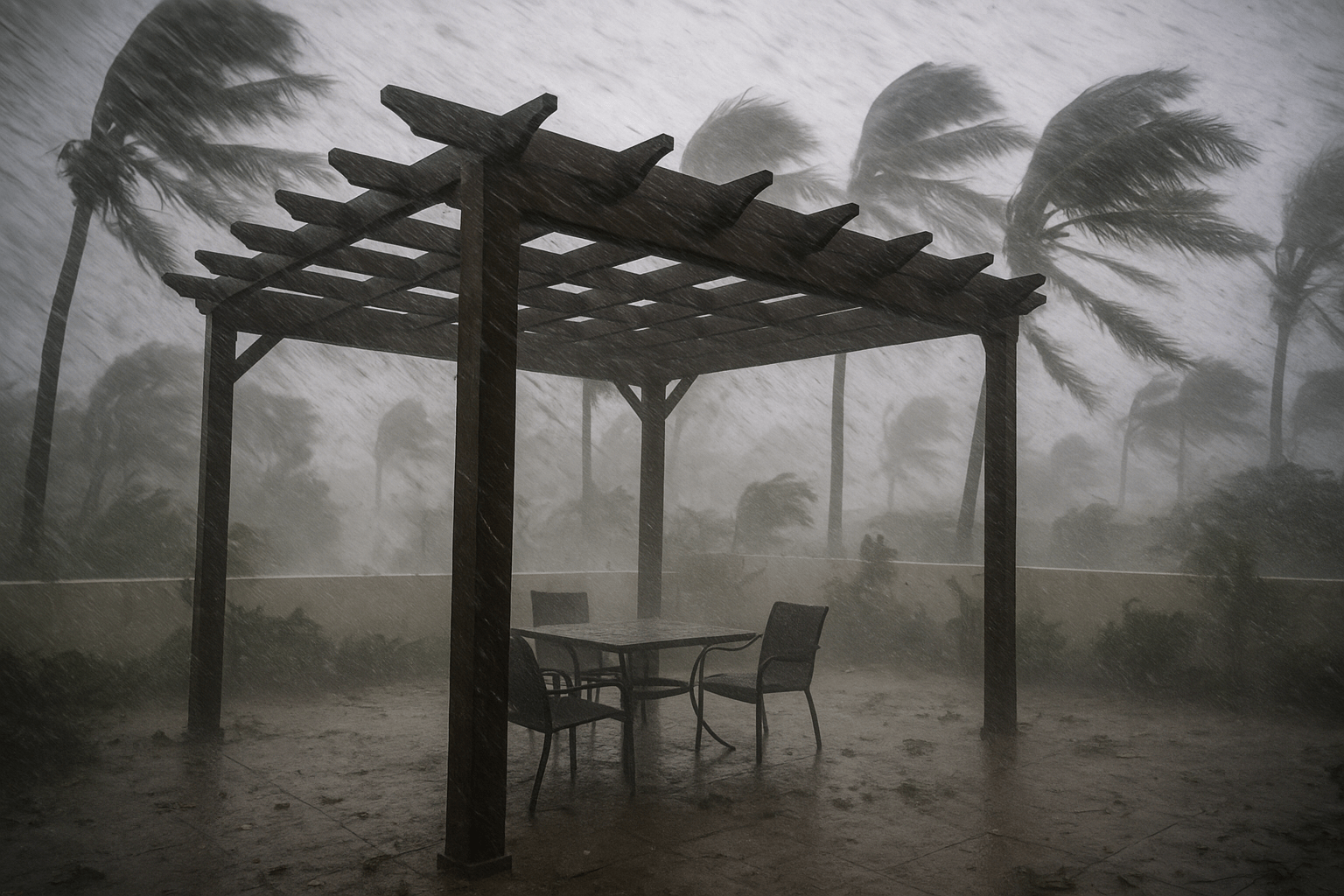
Why Every Coastal Airbnb Needs a Hurricane Proof Pergola
If you own an Airbnb or VRBO near the coast, your listing already has something most properties can’t offer: the allure of ocean breezes, salty air, and stunning views. But these perks also come with a price—hurricane season.
When storm warnings roll in, the last thing you want to worry about is whether your outdoor pergola will survive the next high-wind event. And if you're planning to add one, it's time to think beyond beauty and ask:
Is your pergola hurricane proof?
In this post, we’ll show you exactly what to look for in a hurricane proof pergola, why it’s a must-have upgrade for coastal vacation rentals, and how to choose a design that’s both storm-ready and guest-approved.
A Pergola With Purpose: More Than Just Pretty Shade
A pergola does more than provide structure or define a patio. For guests, it can become a go-to spot for coffee at sunrise or a shady hangout after the beach. It invites connection, comfort, and calm—making your listing feel like a private resort.
But for hosts, it has to do double duty: offering luxury while standing up to harsh weather. And on the coast, that means serious wind resistance.
A hurricane rated pergola doesn’t just elevate aesthetics—it protects your outdoor investment and gives your guests a functional, secure space, season after season.
What Makes a Pergola Hurricane Proof?
Let’s break it down: not all pergolas are created equal. To earn the “hurricane proof” label, your structure needs three key elements—strong materials, smart design, and solid anchoring.
1. Smart Material Choices
Choose materials that can take a hit from mother nature:
- Aluminum: Lightweight yet strong, rust-resistant, and capable of withstanding winds up to 130 mph. A favorite for coastal environments.
- Steel: Incredibly durable and heavy enough to stay grounded during storms. Ideal if treated with protective coatings to avoid rust.
-
Pressure-Treated Wood or Cedar: Visually appealing and slightly flexible, but needs regular upkeep to prevent rot or insect damage.
💡 Tip: Don’t assume heavier is always better—make sure the structure is engineered to handle its own weight during high winds, too.
2. Structural Design Makes a Difference
Even the toughest materials won’t protect you if the design isn’t built for storms.
- Attached vs. Freestanding: Attached pergolas have extra stability from your home’s frame. Freestanding models must be carefully anchored and reinforced.
-
Roof Styles Matter:
- Open Lattice: Allows wind to pass through and reduces pressure buildup.
- Solid Roofs: Provide better shade but may act like sails in high winds.
- Louvered Roofs: Adjustable roofs that you can open in storms to let wind flow freely.
-
Shape & Size: Compact, symmetrical structures offer better wind resistance than large, sprawling pergolas.
3. Anchoring: The Unsung Hero of Wind Resistance
This is where many pergolas fail.
- Concrete Footings: Deeply anchored posts in concrete are ideal—especially for freestanding models.
- Hurricane Straps and Braces: Reinforce connections and reduce movement during wind gusts.
- Ground Anchors or Weighted Bases: Use in sandy soil or when concrete isn’t an option.
-
Secure Deck Mounting: For pergolas installed on decks, make sure the hardware is hurricane-rated.
Pro Tip: If your pergola is already installed, consider retrofitting it with additional storm braces or anchors before peak hurricane season.
4. Strategic Placement
Even a hurricane-rated pergola won’t survive if it’s installed in the wrong place.
- Avoid wide open areas with no wind breaks (like hilltops or exposed patios).
-
Position it near a wall or fence for added support.
-
Angle the structure about 45 degrees to prevailing winds to reduce resistance.
Maintenance Makes It Stronger
Think of a pergola like a car: even the best model needs checkups.
-
Inspect seasonally for rust, rot, or loose joints.
-
Tighten bolts and replace worn fasteners.
-
Lubricate moving parts on louvered roofs.
-
Open louvered roofs before a storm to reduce wind uplift.
Even small actions can dramatically extend your pergola’s lifespan—and prevent expensive repairs after the storm clears.
Hurricane Rated Pergolas: Worth the Investment?
Absolutely.
Many of today’s top models are designed with storm safety in mind. Some meet high-wind zone requirements like Miami-Dade County standards, meaning they’ve been tested to withstand wind speeds of 130+ mph.
Look for certifications or specs that specifically mention:
-
Wind resistance rating
-
Powder-coated or corrosion-resistant finishes
-
Reinforced brackets, fasteners, and base plates
-
Compatibility with hurricane anchor kits
Guest Experience = More Bookings
A well-designed pergola isn’t just a box to check on your amenities list—it’s a booking magnet.
Airbnb and VRBO guests love spaces where they can:
-
Sip wine at sunset without glare
-
Eat outdoors without baking in the heat
-
Snap Instagram-worthy photos under string lights
And when they see a gorgeous, secure pergola in your listing photos, you’re more likely to stand out from the sea of generic rentals nearby.
Real ROI: What Hosts Are Saying
“Our aluminum pergola survived Hurricane Ian without a scratch—while our neighbor’s patio cover flew into a tree.”
– Carla, Airbnb host in Florida
“We just upgraded to a steel pergola with open slats and added string lights underneath. Our summer bookings doubled!”
– Ken & Lisa, Superhosts in North Carolina
Featured: Guest-Ready, Coastal-Tough Pergolas
Here are some excellent pergola and gazebo kits designed with wind resistance and beauty in mind. Perfect for coastal vacation rentals:
-
Sioux Steel Grain Bin Gazebo: Rustic meets reinforced steel—eye-catching and durable.
-
YardCraft Premium Vinyl Oval Gazebo Kit: Elegant design with strong vinyl framing.
-
12×18 Wood Oval Gazebo Kit: Spacious, natural wood with a strong structural frame.
These models are not only visually stunning, but also designed to handle the realities of coastal weather.
Final Thoughts: Don’t Just Upgrade—Stormproof
If you’re a coastal Airbnb or VRBO host, investing in a wind resistant pergola isn’t just smart—it’s essential.
It protects your space.
It adds luxury for your guests.
And it gives you peace of mind when the weather turns.
So don’t just think about shade. Think about strength, structure, and staying power.
After all, the best Airbnb upgrades don’t just look good.
They last.

